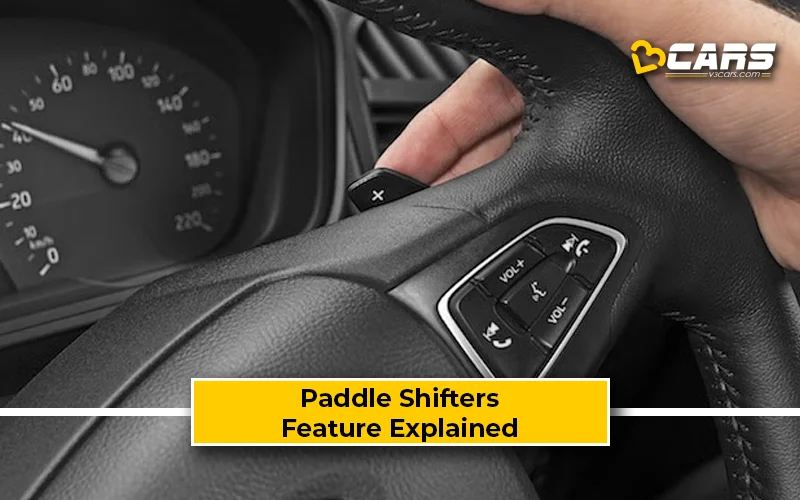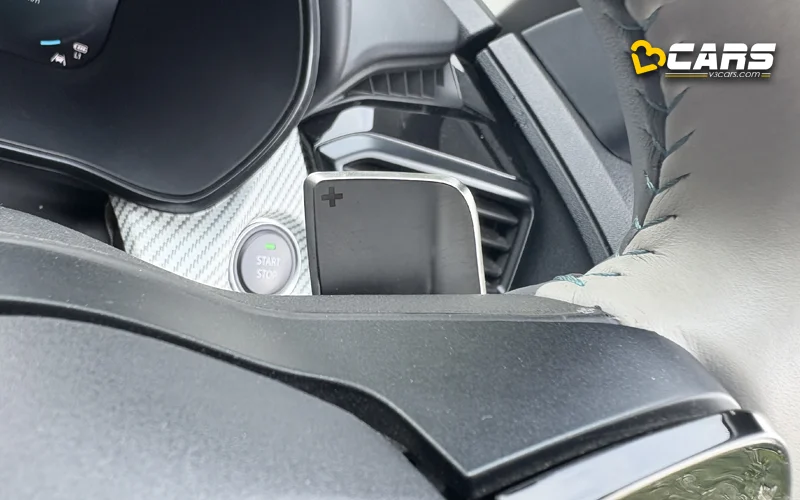Paddle Shifters – Feature Explained
Paddle shifters have become a popular feature in cars these days. They bridge the gap between the convenience of automatic transmissions and the engagement and control of a manual gearbox. Once exclusive to high-performance sports cars and racing vehicles, paddle shifters are now found in a wide range of mainstream cars, offering drivers a more interactive and dynamic driving experience.

What Are Paddle Shifters?
Paddle shifters are small levers or switches mounted directly behind or on the steering wheel. They allow the driver to manually select gears in a vehicle equipped with an automatic transmission, without needing to move their hands from the steering wheel or operate a clutch pedal.
- The right paddle, usually marked with a “+” symbol, is used for upshifting (shifting to a higher gear).
- The left paddle, typically marked with a “-” symbol, is used for downshifting (shifting to a lower gear).
How Do Paddle Shifters Work?
While they offer a manual-like control, paddle shifters operate electronically. When a driver pulls a paddle, an electronic signal is sent to the car’s electronic control unit (ECU). The ECU then interprets this command, taking into account various driving parameters such as engine speed (RPM), vehicle speed, throttle position, and road gradient.
Based on these inputs, the ECU determines if the requested gear change is safe and optimal. If it is, it commands the transmission (whether it’s a dual-clutch transmission, torque converter automatic, CVT or AMT) to execute the gear change. This entire process happens in milliseconds, resulting in quick and seamless shifts.
Most modern cars with paddle shifters allow them to be used in 2 primary ways:
- Manual Mode: The driver shifts the gear lever into a “Manual” or “Sport” mode (often indicated by “M” or “S”). In this mode, the transmission will hold the selected gear and only shift if the driver commands it via the paddles, or if the system detects an unsafe condition (redlining the engine or lugging it at very low RPMs).
- Temporary Manual Override: In some vehicles, even when the car is in standard “Drive” mode, pulling a paddle will temporarily engage manual control. After a short period of inactivity (no paddle inputs), the transmission will revert to its full automatic operation.
Benefits Of Using Paddle Shifters
Paddle shifters offer several advantages that enhance both performance and everyday driving convenience:
- Enhanced driving engagement: They provide a more connected and sporty feel, allowing drivers to feel more involved in the driving process, similar to a manual transmission.
- Optimal power delivery: Drivers can proactively downshift before an overtake or an uphill climb to access immediate power and torque without waiting for the automatic transmission to respond.
- Engine braking: When driving downhill, especially on long descents, downshifting using paddles allows the engine to assist in slowing the vehicle, reducing reliance on the brakes and preventing them from overheating.
- Improved control in challenging conditions: In slippery conditions (rain, snow) or during off-road driving, manually selecting a higher gear can help prevent wheel spin, while a lower gear provides more control.
- Precise gear selection: For spirited driving on winding roads, paddle shifters enable precise gear selection before entering and exiting corners, optimising the car’s balance and acceleration.
- Fuel efficiency: While modern automatics are generally efficient, in certain cruising scenarios, a driver can use the paddles to select a higher gear earlier than the automatic system would, potentially saving a small amount of fuel.
Types Of Transmissions That Use Paddle Shifters
Paddle shifters are commonly found across various types of automatic transmissions:
- Dual-Clutch Transmission (DCT): Known for their lightning-fast shifts, DCTs with paddle shifters offer a highly engaging and performance-oriented experience.
- Torque Converter (TC): Many modern TCs are now equipped with paddle shifters, providing manual override capabilities for added control.
- Continuously Variable Transmission (CVT): While CVTs don’t have traditional “gears,” manufacturers often program “simulated” gear steps that can be accessed via paddle shifters. This helps to mitigate the “rubber band” effect common in CVTs and offers a sense of manual control.
- Automated Manual Transmission (AMT): Found in more budget-friendly automatic cars, AMTs can also feature paddle shifters, offering a basic level of manual gear selection.
Modern transmissions with paddle shifters incorporate safeguards to prevent damage. The ECU will prevent shifts that would cause the engine to over-rev or lug excessively. For instance, it won’t allow a downshift if it would push the engine RPMs beyond a safe limit, nor will it allow an upshift if the current speed is too low for the next gear.
Cars With Paddle Shifters In India
Paddle shifters are becoming increasingly common in the Indian market, appearing in various segments. Some popular models that offer them (often in their automatic variants and higher trims) include:
- Hatchbacks: Hyundai i20 N Line, Maruti Suzuki Fronx
- Sedans: Honda City, Hyundai Verna, Skoda Slavia, Volkswagen Virtus
- SUVs/Crossovers: Hyundai Creta, Kia Seltos, Kia Sonet, Tata Nexon, Tata Punch EV (for regen levels), Honda Elevate, Maruti Suzuki Brezza, Toyota Urban Cruiser Taisor, MG Astor, MG Hector.
- MPVs: Kia Carens
Also Read: Wireless Charger – Feature Explained
Helpful Tools:
Fuel Cost Calculator for Cars – Know your monthly fuel expense based on usage and mileage
Car On-Road Price Calculator – Convert ex-showroom to on-road price for any city
Sell Used Car Online – Enter your car and contact details to get an instant price estimate and book a free inspection with our partner network



0 Comments
MG Cars in India
Hector
₹11.99 - ₹18.99 lakh*
*Ex-showroom priceHector Plus
₹17.29 - ₹19.49 lakh*
*Ex-showroom priceCyberster
₹75.00 lakh*
*Ex-showroom priceM9
₹69.90 lakh*
*Ex-showroom priceWindsor EV
₹14.00 - ₹18.39 lakh*
*Ex-showroom priceComet EV
₹7.50 - ₹10.00 lakh*
*Ex-showroom priceHector
₹14.00 - ₹20.76 lakh*
*Ex-showroom priceHector Plus
₹16.05 - ₹21.34 lakh*
*Ex-showroom priceHector Copy
-
*Ex-showroom priceGloster
₹38.33 - ₹43.17 lakh*
*Ex-showroom priceZS EV
₹17.99 - ₹20.50 lakh*
*Ex-showroom priceAstor
₹9.65 - ₹15.16 lakh*
*Ex-showroom priceUpcoming MG Cars
Astor Facelift
₹10.82 - ₹18.73 lakh*
*Expected PriceExpected Launch Jun 2026
Majestor
-
*Expected PriceExpected Launch Dec 2026
eMG6
-
*Expected PriceExpected Launch Jan 2027
Marvel R
-
*Expected PriceExpected Launch Apr 2027
Euniq 7
-
*Expected PriceExpected Launch Jun 2028
MG4
-
*Expected PriceExpected Launch Oct 2028
MG5
-
*Expected PriceExpected Launch Oct 2028
HS Plug-in
Hybrid
-
*Expected PriceExpected Launch Dec 2028
Marvel X
-
*Expected PriceExpected Launch Feb 2029
G10
-
*Expected PriceExpected Launch May 2029
S5
-
*Expected PriceExpected Launch Oct 2029
RC6
-
*Expected PriceExpected Launch Dec 2029
iML6
-
*Expected PriceExpected Launch Jan 2030
7 Trophy
-
*Expected PriceExpected Launch Jan 2030
3
-
*Expected PriceExpected Launch Jun 2030
IM 5
-
*Expected PriceExpected Launch Jul 2030
IM 6
-
*Expected PriceExpected Launch Oct 2030
Latest MG Cars Videos
MG Astor Turbo Fuel Efficiency Test | Real-World Mileage Compared With MG Hector
MG Windsor EV vs Tata Curvv EV Sub Rs. 19 Lakh Battle | Which Car Is More Value For Money?
All 2025 MG Windsor EV (& Pro) Variants Explained (Excite, Exclusive, Essence) — Which One To Buy?
MG Windsor Pros And Cons Wala Review (Essence Pro: Rs. 18.10 Lakh)
MG Windsor EV Rear Seat & Boot Space Review | Can 3 People Sit In Rear Of Windsor EV?
Hyundai Creta S(O) vs MG Hector Style | Which Car Is More Value For Money?
2024 MG Windsor EV Variants Explained (Excite, Exclusive, Essence) — Which One To Buy?
MG Windsor First Drive Review | This Spacious City EV Is A Mixed Bag
MG Windsor EV Walkaround Review | Rs 10 lakh Price Explained | Interior Space, Battery Warranty
MG Astor Select vs Maruti Suzuki Brezza ZXI+ | Which Car Is More Value For Money?
Astor Important Links